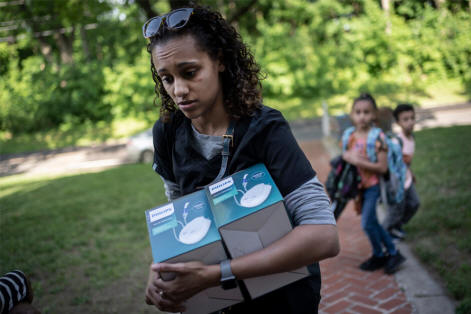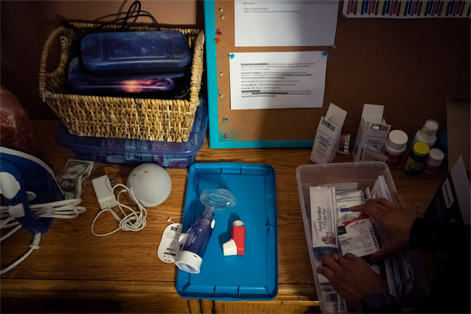|
|
|
|
|
|
 |
|
|
Nearly 4
in 10
African
American
children
live in
areas
with
poor
environmental,
social
and
health
factors
compared
to 1 in
10 white
children,
according
to an
index
that
tracks
neighborhood-level
data.
(APPhotos
by WONG
MAYE-E) |
| |
Medical
Racism
in
History
By KAT
STAFFORD,
AARON
MORRISON,
and
ANNIE MA
apnews.com
The
health
inequities
documented
in this
project
have
their
roots in
a long
history
of
medical
racism.
The AP
has
collected
a small
sample
of that
history
related
to every
phase of
life.
Birth:
Gynecology
James
Marion
Sims, a
19th
century
Alabama
surgeon
heralded
as the
father
of
modern
gynecology,
pioneered
a
treatment
for
vesicovaginal
fistulas,
a
condition
that
affects
bladder
control
and
fertility
in
women.
Between
1845 and
1849,
Sims
carried
out the
once-experimental
surgical
treatment
on a
dozen
enslaved
women
without
the use
of
anesthesia.
He has
been
both
defended
as a
product
of his
era and
panned
as
unethical
and
inhumane.
Sims’
belief
that
Black
people
could
endure
more
pain
than
white
people
is
considered
a form
of
racism
and
still
present
in the
field of
medicine.
From
medical
school
students
of
various
racial
and
ethnic
backgrounds
to
primary
care
providers
of small
and
large
practices,
this
bias has
adversely
impacted
the
health
outcomes
of Black
Americans.
It’s
also a
source
of Black
American
skepticism
of
modern
medicine.
Childhood:
Behavioral
Treatment
Behavioral
challenges
in Black
children,
throughout
history
and
typically
in
educational
settings,
have
been met
with
inequitable,
inhumane
and even
extreme
treatment.
Systemic
racism
in
behavioral
counseling
and
psychotherapy
for
school-age
children
has
meant
lifelong
adverse
consequences
for
generations
of Black
children
– from
the
funneling
of Black
students
with
learning
disabilities
into
special
education
tracks
that
lack
resources
and
overreliance
on
suspension
and
expulsion
to
institutionalization
and
experimental
brain
operations.
Dr.
Orlando
J.
Andy’s
work at
the
University
of
Mississippi
Medical
School
in the
1960s is
one
example.
The
neurosurgeon
testified
that he
performed
30 to 40
lobotomies
and
other
brain
operations
on Black
children
and
other
people
with
behavioral
problems
who had
been
institutionalized.
Although
Andy
said his
operations
were a
last
resort
for
patients
who
lived
with
uncontrolled
destructive
hyperactivity,
the
procedure
was
performed
on
institutionalized
Black
boys as
young as
6. Some
patients
lived
the rest
of their
lives
with
deteriorated
intellectual
capacity.
Teen
Years:
Adultification
Black
children
and
teens
are
often
perceived
as much
older
than
they
are.
Because
of this
bias
known as
“adultification,”
they get
viewed
as less
innocent
and less
deserving
of
empathy
–
resulting
in
harsher,
disparate
treatment
in
health
care and
other
systems.
The
attitudes
date
back to
slavery,
when
Black
children
as young
as 2
were
made to
work and
punished
for
developmentally
appropriate
child
behavior,
according
to
scholars
Michael
J. Dumas
and
Joseph
Derrick
Nelson.
Research
shows
these
attitudes
still
drive
disparities
in
outcomes
for
Black
children
and
teens. A
Yale
study
found
Black
children
are 1.8
times
more
likely
to be
physically
restrained
in a
hospital
emergency
room
than
white
kids, a
gap that
may be
driven
by
hospital
staff’s
view of
Black
children.
Georgetown
researchers
have
found
that
adultification
of Black
girls is
linked
to them
being
treated
more
harshly
in
school.

Catherine
Manson
sorts
through
asthma
medication
for her
children
in
Hartford,
Conn.,
on May
25,
2022.
(APPhotos
by WONG
MAYE-E)
Adulthood:
Studying
black
bodies
University
of
Cincinnati
researchers
led an
experiment
from
1960 to
1972
that
exposed
about 90
poor,
mostly
Black,
terminal
cancer
patients
to
extreme
levels
of
radiation
without
their
consent.
The
Department
of
Defense
funded
it as
part of
Cold War
radiation
experiments,
according
to
Associated
Press
stories.
Dr.
Eugene
Saenger,
one of
the
chief
researchers,
said the
study
was
meant to
find
experimental
treatments
for
patients
with
inoperable
cancer
to see
if he
could
stop the
growth
of
tumors.
But the
patients
and
their
families
said
they
were not
fully
informed
of the
risks or
asked to
sign
consent
forms.
They
also
weren’t
told of
the
Defense
Department’s
involvement
or that
the
results
would be
used to
learn
what
might
happen
to
troops
exposed
to
radiation.
A
federal
court
ruling
noted
the
patients
were
told
they
were
receiving
radiation
for
their
cancer.
The
families’
attorneys
said
many of
the
patients
died
after
the
radiation
or
experienced
shortened
life
expectancies.
A judge
approved
a $5.4
million
settlement
for the
families.
Death:
Stealing
black
bodies
Even in
death,
Black
Americans
haven’t
escaped
racist
acts
denying
them the
dignity
their
final
resting
places
should
have
afforded
them.
Graveyard
diggers
were
often
hired to
exhume
and
remove
the
bodies
of Black
people
for the
sake of
medical
research
and
studies,
unbeknownst
to
family
members.
Harriet
Washington,
author
of the
book
“Medical
Apartheid,”
noted
that
Black
graveyards
were
regularly
targeted
–
including
by Dr.
John D.
Goodman,
who in
1829
wrote
that he
paid the
manager
of a
public
graveyard
“for the
privilege
of
‘emptying
the
pits’ of
about 50
to 85
cadavers
a month
during
each
‘dissection
season.’”
Bodies
were
typically
exhumed
during
the
cooler
months
to align
with the
academic
year.
Washington
wrote
that
historian
Todd
Savitt
said
Black
people
were
well
aware of
the
grave
robbery
that
occurred,
as
evidenced
by one
elderly,
enslaved
Virginia
woman
who once
said:
“Please
God, I
hope
when I
die,
it’ll be
the
summertime.”
Digital
Presentation
Credits
Producers:
Samantha
Shotzbarger,
Josh
Housing
Data
Analysis:
Angeliki
Kastanis
Text
Editing:
Anna Jo
Bratton,
Andale
Gross
Illustrations:
Peter
Hamlin
Design
and
Development:
Linda
Gorman,
Kati
Perry
and
Eunice
Esomonu
Audience
Coordination
and
Production:
Ed
Medeles,
Elise
Ryan,
Almaz
Abedje
and
Sophie
Rosenbaum
Creative
Development:
Raghuram
Vadarevu
Project
Management:
Andale
Gross
Project
Vision
and
Development:
Kat
Stafford
Stafford,
based in
Detroit,
is a
national
investigative
race
writer
for the
AP’s
Race and
Ethnicity
team.
She was
a 2022
Knight-Wallace
Reporting
Fellow
at the
University
of
Michigan.
|
|
|
|
|
|
|
|
|